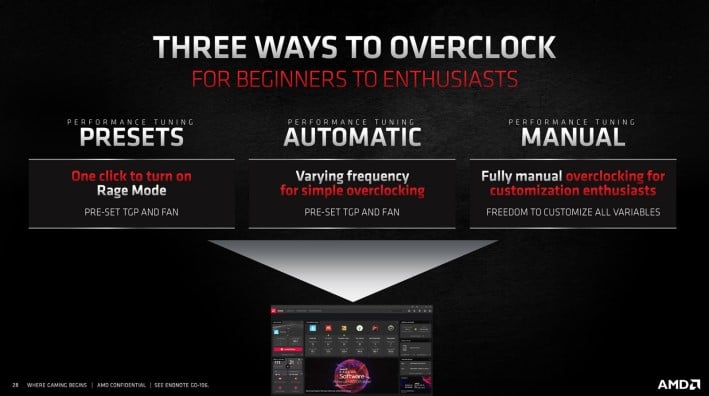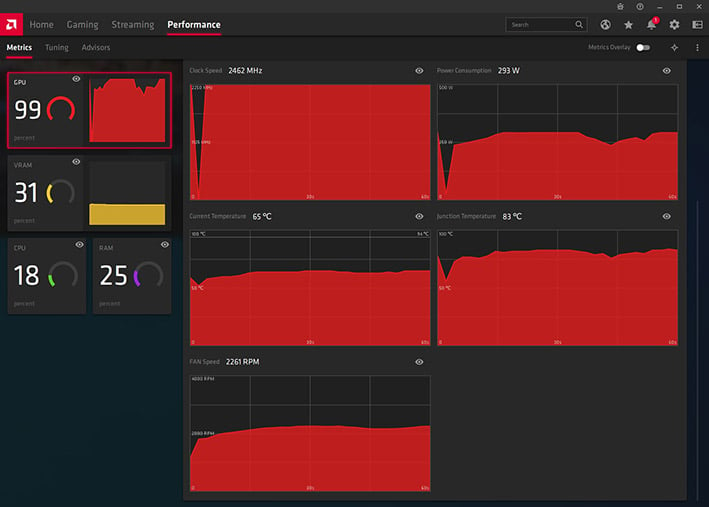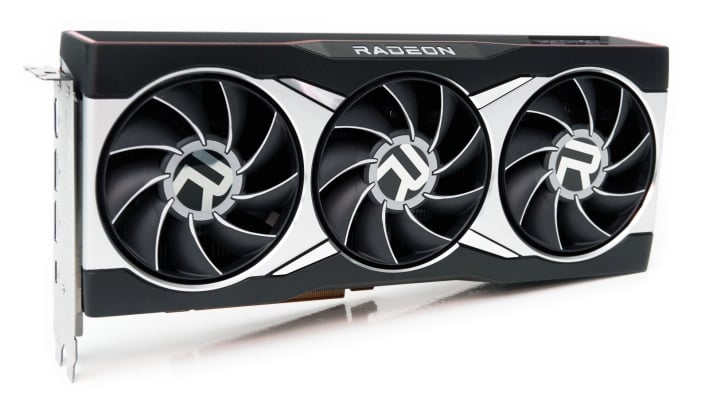Radeon RX 6900 XT Review: AMD's Most Powerful Gaming GPU Ever
AMD Radeon RX 6900 XT: Overclocking, Power, Noise And The Verdict
With the tuning options built into AMD's driver suite, users have multiple ways to tweak a Radeon RX 6900 XT's performance. Users can manually alter frequencies, memory timings, voltages, fan speeds, and the max power target using percentages or finer-grained numerical sliders, or they can opt to use various preset modes or auto-tune a number of characteristics, including GPU and memory frequencies as well as GPU voltage, including under-volting.
With previous-generation Radeons, though the GPUs had multiple sensors built-in, a single sensor had been used to determine the GPU temperature and data from that lone sensor was used to control the card's thermal profile. With newer GPUs, like the Navi 21-based Radeon RX 6900 XT, AMD has incorporated a network of multiple thermal sensors at strategic locations across the die. Data gathered from the sensors is used to determine what AMD is calling the "Junction Temperature", and it's the Junction Temperature that is used to tune the card's power and thermal profiles (the Junction Temperature is effectively the hottest part of the GPU die at any given time). AMD claims the increased resolution and accuracy from the additional thermal sensors allows it to increase overall sustained performance, because throttling based on the Junction Temperature is more reliable and effective.

The tuning options built into AMD's Radeon Software suite offer manual controls, along with automatic under-volting and automatic GPU and Memory overclocking. Finding the lowest stable voltage and highest stable memory and GPU clocks, at the lowest voltage possible, while simultaneously increasing the max power target and keeping temperatures low, will yield the best overall overclocking results. If you'd rather not muck around though, you could simply enable Rage Mode, which essentially increases the power target and fan speeds, to increase the game / boost clocks, and eek out a bit of extra performance.
At its stock settings, we saw the GPU clock typically hovering in the 2,250 - 2,350MHz range while gaming (give or take) with our particular Radeon RX 6900 XT sample. With a little tweaking we found that we could easily max-out the memory clock on our card to 2,150MHz (17.2Gbps) with Fast memory timings enabled, and with a mild under-volt to 1,160mV, a max frequency set to 2,775MHz, and +15% to the power target, we typically saw a wider-range of real-world game clocks, commonly in the 2,400MHz - 2,500MHz range, though it occasionally spiked higher. The junction temperature while overclocked peaked in the mid 80°C range with these settings, with a slight bump to the fan curve into the 2,200-ish RPM range.
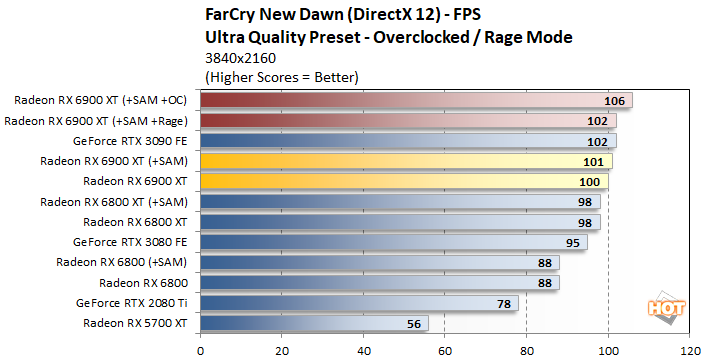
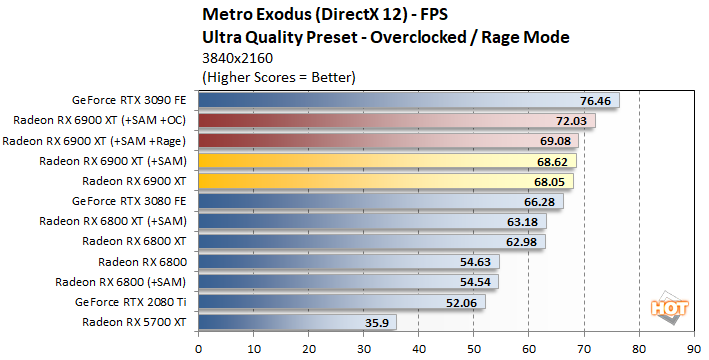
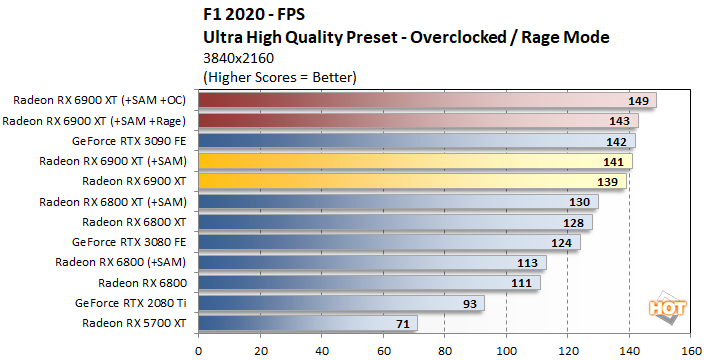
While we had the card overclocked, we saw some nice performance boosts. Rage mode provided a slight bump in performance, but with the manual overclock, the Radeon RX 6900 XT stretched its legs and was able to overtake the GeForce RTX 3090 in FarCry New Dawn and F1 2020.
Considering how well our card overclocked with the stock cooler, we're eager to see what these cards can do with more exotic cooling. The Radeon RX 6900 XT still has some gas in the tank, should AMD want to further tweak its power and frequencies going forward.
|
|
|
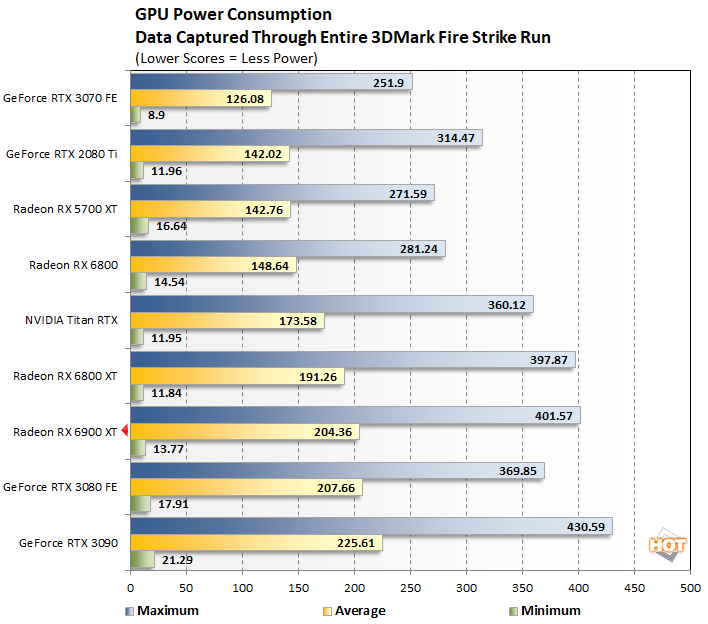
|
Although the Radeon RX 6900 XT is more power efficient and features more capable cooling solutions than previous-gen Radeons, it is still somewhat louder than competing NVIDIA solutions...
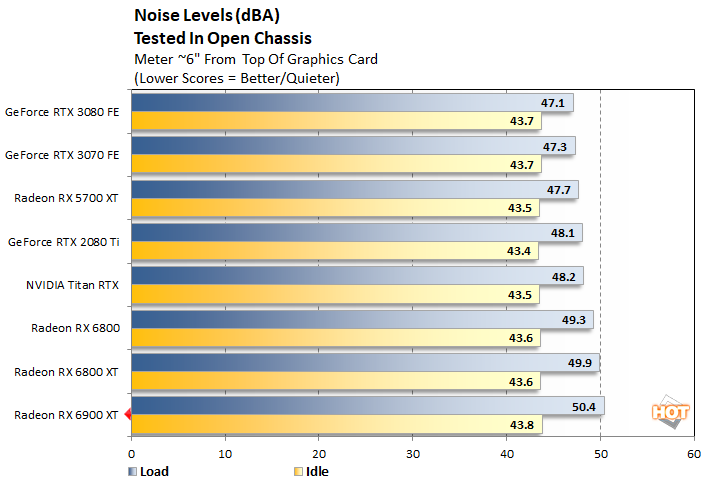
In our real-world setup (we tested the GPUs inside a chassis), the Radeon RX 6900 XT technically produced the highest sound pressure level, but we would not consider the card loud by any means. The default fan curve is a little more aggressive than some other cards, but in a PC case, with other moving parts and fans, we doubt anyone would be put off by the Radeon RX 6900 XT's acoustic profile.
AMD Radeon RX 6900 XT Summary And Verdict
The AMD Radeon RX 6900 XT has an MSRP of $999, which firmly places it at the ultra-high end of the gaming GPU market. In comparison to the $1,499 GeForce RTX 3090, the Radeon RX 6900 XT seems like a relative value (we use that term loosely), if you're not playing many ray tracing-enabled games. With traditional rasterization, the Radeon RX 6900 XT and GeForce RTX 3090 are fairly nip and tuck, and trade victories depending on the title, though the RTX 3090 does have the overall edge. Turn on Rage mode and things tighten up a bit. Do some overclocking and the battle gets even more fierce. With ray tracing enabled, however, the NVIDIA cards have a clear advantage. For the most part, the Radeon RX 6900 XT compares favorably to a GeForce RTX 2080 Ti in ray tracing-enabled titles, but versus the GeForce RTX 3080 or RTX 3090, NVIDIA has a significant lead. Power consumption is surprisingly similar between all of the high-end cards, and though technically a bit louder, there aren't any wild acoustic concessions to make either. If consumers could actually buy any of these newest, current-gen GPUs, there are great options up and down the stack right now, that are massive upgrades over the previous-gen.
But, what's the bottom line? The AMD Radeon RX 6900 XT rocks. Is it the fastest card across the board? No. But it is an immensely powerful and capable GPU, with a beefy 16GB of memory, a leading-edge feature set, and obvious synergy with current-gen game console architectures, which should bode well for game development and optimizations moving forward. The XBox Series X, PlayStation 5, and Radeon RX 6800 series all share the same GPU architecture, so game developers should be able to wring every ounce of performance and leverage many of the GPU's features without having to re-invent the wheel. The Radeon RX 6900 XT is also highly tunable. We've only had the card on hand for about a week, and even with a minimal amount of experimentation, some decent overclocks were possible. We're eager to see what AMD's board partners do with the 6900 XT, when more aggressively tuned custom boards arrive. We think extreme overclockers are going to hit some insane clocks with these cards.
The Radeon RX 6900 XT propels AMD back into a competitive position in the ultra high-end GPU space. It's fun, it's fast, and although it's pricey, it is well-positioned relative to competing offerings from NVIDIA.

|
|

